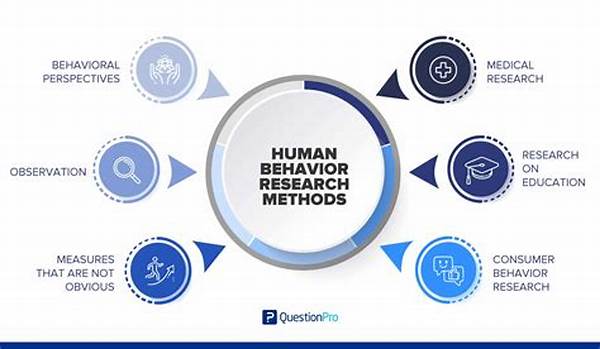In the rapidly evolving digital age, understanding how users interact with search engines is crucial for businesses, marketers, and researchers. Analysis methods for search behavior have become pivotal in unveiling patterns, preferences, and peculiarities in the way individuals seek information. With cutting-edge techniques ranging from data mining to machine learning, experts can decode user queries, predict trends, and enhance user experience. In this article, we’ll delve into various strategies used to dissect search behavior.
Read Now : Indie Music Festival Tracks 2023
Exploring Search Behavior Analysis
Imagine diving into the tangled web of user searches – it’s like trying to understand the chaos inside a teenager’s mind. Analysis methods for search behavior encompass a range of approaches to make sense of this chaos. From data mining to eye-tracking, these methods help us understand why someone types “cat videos” at 3 a.m. or “how to cook pasta” during lunch breaks.
These analysis methods for search behavior provide insights into user intent, allowing companies to tailor content, improve SEO strategies, and even develop new products. It’s like having a backstage pass to the mind of your audience. Moreover, search behavior analysis can predict future trends, turning raw data into valuable business intelligence.
Incorporating these insights can significantly boost a company’s digital presence. Just think of it as upgrading your old bike to a sleek motorbike – faster, more efficient, and way cooler. Companies keen on staying ahead must harness the power of search behavior analysis to remain competitive. It’s not just about understanding the ‘what’; it’s about digging into the ‘why’ and ‘how’ people search online.
Key Techniques in Search Behavior Analysis
1. Data Mining: Sifting through data like a prospector in search of gold nuggets, these analysis methods for search behavior help find patterns in voluminous datasets.
2. Clickstream Analysis: It’s like reading a user’s mind, tracking every search and click, offering a roadmap to their preferences.
3. Eye-Tracking Studies: Looking into what catches a user’s eye. These methods reveal where users pause, what they skip, and what grabs their attention instantly.
4. User Surveys: Old but gold, asking users directly still provides valuable insights into their thought processes and search habits.
5. A/B Testing: This trial-and-error tactic sorts what’s working from what’s not, refining the analysis methods for search behavior to perfection.
The Role of Technology in Search Behavior Analysis
Tech’s role in analysis methods for search behavior is gigantic. Algorithms and AI are like the secret sauce, turning bland data into savory insights. As technology advances, so do the methods used to analyze search behavior. Machine learning, natural language processing, and advanced data analytics are at the forefront, continuously evolving to keep pace with ever-changing search patterns.
By leveraging technology, businesses can sift through mountains of data swiftly, identifying underlying trends and adapting in real time. It’s like having a digital crystal ball, offering a glimpse into the future of search trends. This predictive power is invaluable, helping businesses tailor their strategies, connect with their audience on a personal level, and maintain a competitive edge.
Moreover, analysis methods for search behavior backed by technology enable a deeper understanding of user preferences and pain points. By identifying these elements, businesses can enhance their user experience, fostering loyalty and long-term engagement. It’s a win-win scenario – happy users and successful businesses.
Emerging Trends in Search Behavior Analysis
1. Voice Search: As smart assistants become household staples, understanding speech patterns becomes crucial in search behavior analysis.
2. Mobile Search: With everyone browsing on the go, the focus is shifting to analyzing mobile search intricacies.
3. AI Implementation: Machine learning algorithms are revolutionizing how search behaviors are interpreted and utilized.
Read Now : Weekly Indie Music Roundup
4. Personalization: Tailoring content to meet individual user preferences is a burgeoning trend.
5. Cross-Platform Analysis: Users jump between devices, and so should the analysis – understanding this behavior is key.
6. Visual Search: Recognizing that sometimes, a picture is worth a thousand words is important in evolving search methodologies.
7. Sentiment Analysis: Delving into the sentiment behind queries offers a richer understanding of user needs.
8. Real-Time Analytics: Immediate data interpretation allows for quick strategic pivots.
9. Security Concerns: As data analysis grows, so does the need for stringent privacy and security measures.
10. Integration with Marketing: Merging search behavior insights with marketing strategies yields powerful campaigns.
How to Implement Search Behavior Analysis
Getting into the nitty-gritty of analysis methods for search behavior is no small feat. It’s like trying to find a needle in a haystack, but tech makes it easier. Begin by collecting extensive data – the more, the merrier, they say. Then, apply sophisticated algorithms to unearth patterns and anomalies.
Engage with user feedback through surveys and combine it with technological insights for a comprehensive picture. Think of it as mixing old-school detective work with high-tech snooping. This blend can yield actionable insights into user wants and needs.
Ultimately, staying ahead in the game requires continuous adaptation. Keep an eye on emerging trends, tweak strategies accordingly, and invest in tech advancements. By understanding and implementing these analysis methods for search behavior, businesses can transform an overwhelming ocean of data into a clear roadmap for future success.
Conclusion on Search Behavior Analysis
In the fast-paced digital world, staying on top means moving with the tide. Brushing up on analysis methods for search behavior isn’t just an option; it’s a necessity. By continuously expanding their analytical toolkit, businesses can uncover invaluable insights and stay ahead of the curve. Remember, it’s not just about following trends – it’s about setting them.
Despite the challenges, the rewards of mastering search behavior analysis are immense. It empowers companies to personalize their offerings, engage effectively with their audience, and drive innovation. So, grab your data mining tools and dive in – the future of search behavior analysis awaits!
